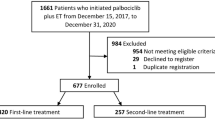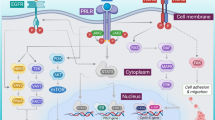Abstract
Background
Eribulin mesylate (eribulin), a non-taxane microtubule dynamic inhibitor, has been widely used in the treatment of patients with advanced or metastatic breast cancer. The combined antitumor and anticancer stem cell (CSC) activities of eribulin with endocrine therapeutic agents have not yet been examined in breast cancer cells. We herein investigated the combined effects of eribulin and antiestrogens.
Methods
A panel of eight breast cancer cell lines, including five estrogen receptor (ER)-positive and three ER-negative cell lines, was used. These cells were treated with eribulin and/or the antiestrogen, 4-hydroxytamoxifen or fulvestrant. Their growth inhibitory activities and effects on cell cycle progression, apoptosis, and the CSC population were investigated. CSCs were detected using the CD44/CD24/EpCAM, Aldefluor, and mammosphere assays.
Results
The 50 % growth inhibitory concentrations of eribulin were 0.38–2.64 nM for the eight cell lines tested. Eribulin exhibited significant antitumor activity under estrogen-supplemented conditions in ER-positive breast cancer cells. The combined antitumor activity of eribulin with an antiestrogen was evaluated using the combination index. The combination index was 0.43–1.46 for ER-positive cell lines. The additive antitumor effect of eribulin with 4-OHT was only significant in MCF-7 cells. Eribulin induced the accumulation of G2/M and apoptosis, while antiestrogens induced the retardation of G1–S cell cycle and apoptosis, respectively. Estrogen markedly increased the proportion of CSCs, whereas antiestrogens inhibited increases in ER-positive cell lines. Moreover, eribulin decreased the proportion of CSCs in either ER-positive or ER-negative cell lines. The combined treatment of eribulin with an antiestrogen did not additively decrease the proportion of CSCs in ER-positive cell lines.
Discussion
The results of the present study demonstrated that eribulin had potent antitumor effects on estrogen-stimulated ER-positive breast cancer cells and the combined treatment of eribulin with an antiestrogen resulted in a weakly additive antitumor effect. We herein suggested for the first time that eribulin exhibited anti-CSC effects on either ER-positive or ER-negative breast cancer cells.






Similar content being viewed by others
References
Cortes J, O’Shaughnessy J, Loesch D, Blum JL, Vahdat LT, Petrakova K, et al. EMBRACE (Eisai Metastatic Breast Cancer Study Assessing Physician’s Choice Versus E7389) investigators: Eribulin monotherapy versus treatment of physician’s choice in patients with metastatic breast cancer (EMBRACE): a phase 3 open-label randomised study. Lancet. 2011;377(9769):914–23.
Kaufman PA, Awada A, Twelves C, Yelle L, Perez E, Wanders J, et al. A phase III, open-label, randomized, multicenter study of eribulin mesylate versus capecitabine in patients with locally advanced or metastatic breast cancer previously treated with anthracyclines and taxanes. 2012 San Antonio Breast Cancer Symposium. Abstract S6-6.
Bezwoda WR, Derman D, De Moor NG, Lange M, Levin J. Treatment of metastatic breast cancer in estrogen receptor positive patients. A randomized trial comparing tamoxifen alone versus tamoxifen plus CMF. Cancer. 1982;50:2747–50.
Viladiu P, Alonso MC, Avella A, Beltrán M, Borrás J, Ojeda B, Bosch FX. Chemotherapy versus chemotherapy plus hormonotherapy in postmenopausal advanced breast cancer patients. A randomized trial. Cancer. 1985;56:2745–50.
Pritchard KI, Paterson AH, Paul NA, Zee B, Fine S, Pater J. Increased thromboembolic complications with concurrent tamoxifen and chemotherapy in a randomized trial of adjuvant therapy for women with breast cancer. National Cancer Institute of Canada Clinical Trials Group Breast Cancer Site Group. J Clin Oncol. 1996;14:2731–7.
Kurebayashi J, Nukatsuka M, Nagase H, Nomura T, Hirono M, Yamamoto Y, et al. Additive antitumor effect of concurrent treatment of 4-hydroxy tamoxifen with 5-fluorouracil but not with doxorubicin in estrogen receptor-positive breast cancer cells. Cancer Chemother Pharmacol. 2007;59:515–25.
Kurebayashi J, Nukatsuka M, Sonoo H, Uchida J, Kiniwa M. Preclinical rationale for combined use of endocrine therapy and 5-fluorouracil but neither doxorubicin nor paclitaxel in the treatment of endocrine-responsive breast cancer. Cancer Chemother Pharmacol. 2010;65:219–25.
Sugimachi K, Maehara Y, Akazawa K, Nomura Y, Eida K, Ogawa M, et al. Postoperative chemo-endocrine treatment with mitomycin C, tamoxifen, and UFT is effective for patients with premenopausal estrogen receptor-positive stage II breast cancer. Nishinihon Cooperative Study Group of Adjuvant Therapy for Breast Cancer. Breast Cancer Res Treat. 1999;56:113–24.
Noguchi S, Koyama H, Uchino J, Abe R, Miura S, Sugimachi K, et al. Postoperative adjuvant therapy with tamoxifen, tegafur plus uracil, or both in women with node-negative breast cancer: a pooled analysis of six randomized controlled trials. J Clin Oncol. 2005;23:2172–84.
Ohashi Y, Watanabe T, Sano M, Koyama H, Inaji H, Suzuki T. Efficacy of oral tegafur–uracil (UFT) as adjuvant therapy as compared with classical cyclophosphamide, methotrexate, and 5-fluorouracil (CMF) in early breast cancer: a pooled analysis of two randomized controlled trials (N.SAS-BC 01 trial and CUBC trial). Breast Cancer Res Treat. 2010;119:633–41.
Liu S, Wicha MS. Targeting breast cancer stem cells. J Clin Oncol. 2010;28:4006–12.
Li X, Lewis MT, Huang J, Gutierrez C, Osborne CK, Wu MF, et al. Intrinsic resistance of tumorigenic breast cancer cells to chemotherapy. J Natl Cancer Inst. 2008;100:672–9.
Tanei T, Morimoto K, Shimazu K, Kim SJ, Tanji Y, Taguchi T, et al. Association of breast cancer stem cells identified by aldehyde dehydrogenase 1 expression with resistance to sequential Paclitaxel and epirubicin-based chemotherapy for breast cancers. Clin Cancer Res. 2009;15:4234–41.
Fillmore CM, Gupta PB, Rudnick JA, Caballero S, Keller PJ, Lander ES, Kuperwasser C. Estrogen expands breast cancer stem-like cells through paracrine FGF/Tbx3 signaling. Proc Natl Acad Sci USA. 2010;107:21737–2142.
Deng H, Zhang XT, Wang ML, Zheng HY, Liu LJ, Wang ZY. ER-α36-mediated rapid estrogen signaling positively regulates ER-positive breast cancer stem/progenitor cells. PLoS One. 2014;9:e88034.
Kurebayashi J, Kurosumi M, Sonoo H. A new human breast cancer cell line, KPL-1 secretes tumour-associated antigens and grows rapidly in female athymic nude mice. Br J Cancer. 1995;71:845–53.
Kurebayashi J, Kurosumi M, Sonoo H. A new human breast cancer cell line, KPL-3C, secretes parathyroid hormone-related protein and produces tumours associated with microcalcifications in nude mice. Br J Cancer. 1996;74:200–7.
Kurebayashi J, Otsuki T, Tang CK, Kurosumi M, Yamamoto S, Tanaka K, et al. Isolation and characterization of a new human breast cancer cell line, KPL-4, expressing the Erb B family receptors and interleukin-6. Br J Cancer. 1999;79:707–17.
Yamashita T, Kurebayashi J, Kanomata N, Shimo T, Moriya T, Sonoo H. Effects of antiestrogens on regulation of cancer stem cell population in breast cancer cells. Breast. 2013;22:S33–4.
Kurebayashi J, Kanomata N, Moriya T, Kozuka Y, Watanabe M, Sonoo H. Preferential antitumor effect of the Src inhibitor dasatinib associated with a decreased proportion of aldehyde dehydrogenase 1-positive cells in breast cancer cells of the basal B subtype. BMC Cancer. 2010;10:568.
Ropero S, Menéndez JA, Vázquez-Martín A, Montero S, Cortés-Funes H, Colomer R. Trastuzumab plus tamoxifen: anti-proliferative and molecular interactions in breast carcinoma. Breast Cancer Res Treat. 2004;86:125–37.
Shimo T, Kurebayashi J, Kanomata N, Yamashita T, Kozuka Y, Moriya T, Sonoo H. Antitumor and anticancer stem cell activity of a poly ADP-ribose polymerase inhibitor olaparib in breast cancer cells. Breast Cancer. 2014;21:75–85.
Yoshida T, Ozawa Y, Kimura T, Sato Y, Kuznetsov G, Xu S, et al. Eribulin mesilate suppresses experimental metastasis of breast cancer cells by reversing phenotype from epithelial–mesenchymal transition (EMT) to mesenchymal–epithelial transition (MET) states. Br J Cancer. 2014;110:1497–505.
Agoulnik SI, Kawano S, Taylor N, Oestreicher J, Matsui J, Chow J, et al. Eribulin mesylate exerts specific gene expression changes in pericytes and shortens pericyte-driven capillary network in vitro. Vasc Cell. 2014;6:3.
Al-Hajj M, Wicha MS, Benito-Hernandez A, Morrison SJ, Clarke MF. Prospective identification of tumorigenic breast cancer cells. Proc Natl Acad Sci USA. 2003;100:3983–8.
Nakshatri H, Srour EF, Badve S. Breast cancerstem cells and intrinsic subtypes: controversies rage on. Curr Stem Cell Res Ther. 2009;4:50–60.
Charafe-Jauffret E, Ginestier C, Iovino F, Wicinski J, Cervera N, Finetti P, et al. Breast cancer cell lines contain functional cancer stem cells with metastatic capacity and a distinct molecular signature. Cancer Res. 2009;69:1302–13.
Douville J, Beaulieu R. Balicki D.ALDH1 as a functional marker of cancer stem and progenitor cells. Stem Cells Dev. 2009;18:17–25.
Radisky DC, LaBarge MA. Epithelial–mesenchymal transition and the stem cell phenotype. Cell Stem Cell. 2008;2:511–2.
Acknowledgments
Esai Co. kindly provided us with eribulin for this study. We thank Dr. Yasumitsu Nishimura and Dr. Takemi Otsuki of the Department of Hygiene, Kawasaki Medical School for their technical advice. We also thank Mrs. Kaoru Tsuboi and Ms. Megumi Ogo for their technical assistance. This work was supported by Research Project Grants from Kawasaki Medical School (25-12 and 26-5) and by Research Grants from Eisai Co. and the Ministry of Education, Culture, Sports, Science, and Technology, Japan (23591911 and 26461964).
Conflict of interest
Junichi Kurebayashi received a research grant from Esai Co. The other authors declare that they have no conflict of interest.
Author information
Authors and Affiliations
Corresponding author
About this article
Cite this article
Kurebayashi, J., Kanomata, N., Yamashita, T. et al. Antitumor and anticancer stem cell activities of eribulin mesylate and antiestrogens in breast cancer cells. Breast Cancer 23, 425–436 (2016). https://doi.org/10.1007/s12282-014-0580-9
Received:
Accepted:
Published:
Issue Date:
DOI: https://doi.org/10.1007/s12282-014-0580-9




